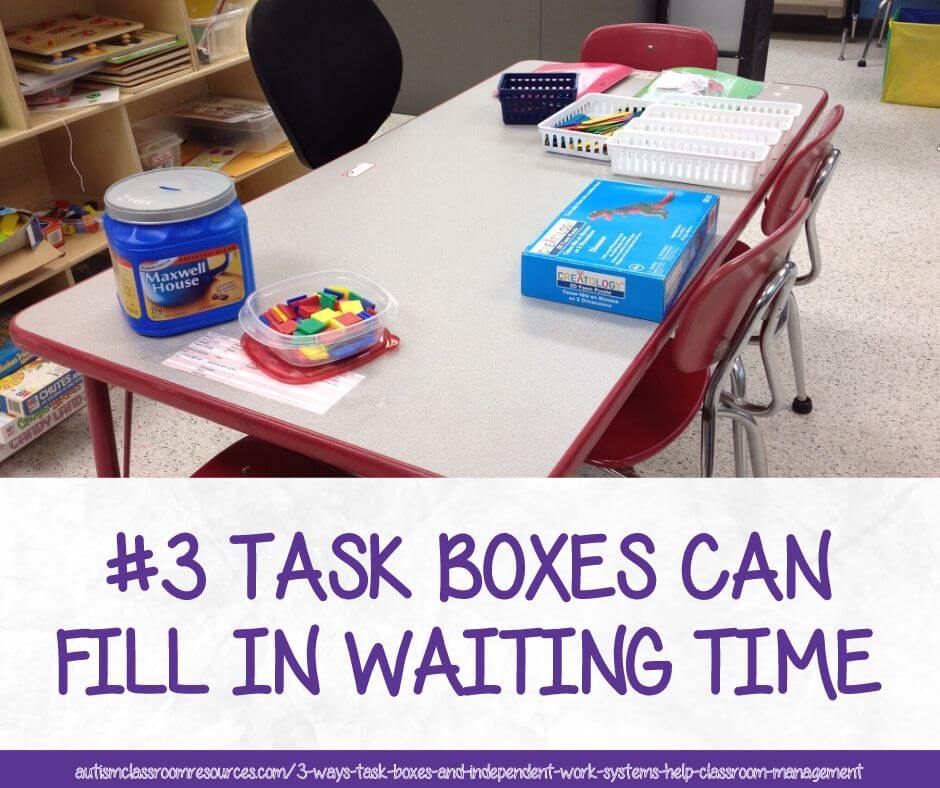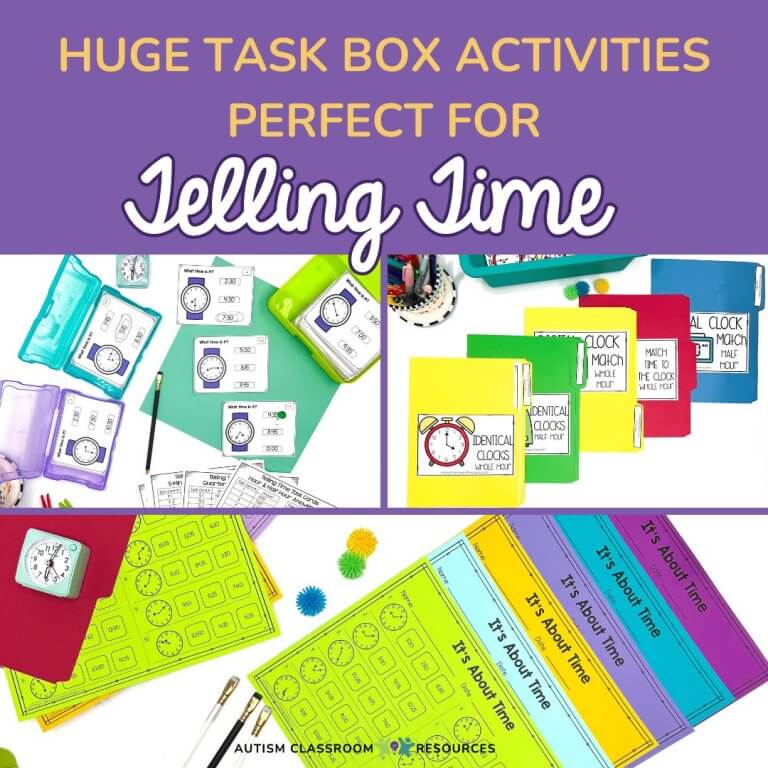So many times, teachers I talk to are using independent work task boxes (also called task box systems and structured work systems), but they don’t know how much they can help outside of just independent work time. Those same educators often talk about how they feel like behavior crises are happening so regularly in their classrooms that they struggle to keep a routine and structure in place.
I love independent work systems so much I wrote a book about them. But we all love them because they promote independence, something many of our students struggle with. In addition, they can be used in lots of different settings (e.g., general education setting, self contained classroom, job sites). And they give students a chance to show that they can complete tasks independently and this is a boost to their self-esteem.
![Independent Work-3 Ways It can Become Your Best Classroom Management Tool [A sorting task in a shoebox to sort nouns from verbs on popsicle sticks into plastic cups]](https://autismclassroomresources.com/wp-content/uploads/2023/06/BLOG-22208-3-Ways-Task-Boxes-and-IW-Help-Classroom-Management-2.jpg)
But, what if I told you that independent work systems can help you reduce the impact that crises have on your everyday routine?
This is an advantage of task box systems that we rarely talk about. But independent work systems allows you to pivot when the unexpected happens and even to help prevent and reduce challenging behaviors. Here are 3 ways it can help you.
3 Ways Independent Work Task Boxes Can Help With Classroom Management
#1 Have to Address a Behavior Crisis in the Classroom?
One of the reasons that behavior crises are so difficult to manage in the classroom is that it sets the whole class off schedule. But more importantly, they require the attention of more staff, which means that other students might not remain engaged.
I’ve talked about how magical engagement is in the classroom and why in this podcast episode. But the short version is that it’s harder to re-engage students than to maintain their engagement. And engagement often leads to challenging behaviors from the students who weren’t originally demonstrating challenging behavior. This is one of the reasons that we sometimes feel like firefighters instead of teachers.
![Independent Work-3 Ways It can Become Your Best Classroom Management Tool: #1 During a Behavior Crisis [picture of interlocking blocks being built to match a pattern on a card]](https://autismclassroomresources.com/wp-content/uploads/2023/06/BLOG-22208-3-Ways-Task-Boxes-and-IW-Help-Classroom-Management-3.jpg)
One solution is to have tasks that students will engage with more independently and redirect them to do that while you (and others) deal with the classroom. Task boxes and independent work systems fit that criteria. Even if they aren’t independent, they will need less supervision there. And they are more likely to stay engaged. I talk about this when I describe Table Tasks in this post.
It’s not ideal for instruction to do all the time, but it makes it more likely that the rest of the class will stay on task. And it makes it more likely that when the crisis is over, you can pick up with instruction because you haven’t lost engagement of the whole class.
#2 Independent Work Task Boxes Can Be Used to Reduce or Prevent Challenging Behavior
If you have a student who is having a difficult day, you may be able to prevent some escalation by increasing independent work. You can use the whole system itself or you can use just task boxes from the system integrated into your direct instruction.
You can also use the system materials to structure your instruction with the student and keep them on task. Just organize the work with a basket for each task, use tasks with clear beginnings and ends, and use the finished basket when the task is complete. This helps the student know how much work they need to complete and what the next activity was. This provides visual cues and structure to the tasks so students know what to expect.

You can also use the structured work system itself as a task or area for the student to calm down. In fact, many students I’ve worked with find them calming. And research shows that IW systems can actually reduce stereotypical behavior for some students.
When I get overwhelmed by something, I don’t tackle the hardest work I need to do. I start with something easy, particularly if I’m really anxious I tend to do easy things that don’t require much concentration.
Because task boxes for the work systems are designed for students to practice tasks that have already mastered, many of them prefer work systems over other types of instruction. It also allows them to complete tasks and work independently. The systems are organized and clear, so students know what to expect with the visual cues. And it means they get a rest from constantly being directed by teachers. Given how much adult prompting our students often receive, practicing independence is a huge priority for many of them.
#3 Structured Work Systems and Task Boxes Can Fill in Waiting Time
Have some sudden unexpected downtime because a specials teacher is absent? Or just have to wait before moving on to the next class? There are so many factors out of our control, that even the best planned schedule is bound to go off schedule sometimes. And that’s when you need to have
Send students to independent work. Or pull the work tasks out in another area and do table tasks. Completing tasks that focus on visual – motor skills instead of language is a great way to have students stay engaged and still be learning.

Looking for More Ideas for Independent Work Task Boxes?
Grab all my independent work tasks in my store here.
Summing Up How Task Boxes Can Be For More Than Independent Work
Doing these types of independent work task boxes can help your students learn to generalize learned skills to different materials and situations. They also practice skills they have learned for maintenance. And they can even try some tasks that might be a little higher than their mastery level (outside the work systems of course). This can allow you to assess skills they have mastered that might surprise you. Or determine which tasks would be good candidates for the independent work systems.
One of the keys to managing the unexpected in the classroom environment is maintaining engagement. The key to preventing challenging behavior is maintaining engagement. IW systems are a great way to do that.
No matter how good your classroom organization is or how consistent you try to keep your schedule, there will always be times that you can’t control that involve waiting or having to staff a period of the day with fewer staff than planned. Independent work systems can be a great help throughout the school year in keeping the magic of engagement going in your classroom. And that help increase instruction time and decrease or prevent challenging behaviors.
Other Resources You Might Like:
![Independent Work-3 Ways It can Become Your Best Classroom Management Tool [A sorting task in a shoebox to sort nouns from verbs on popsicle sticks into plastic cups]](https://autismclassroomresources.com/wp-content/uploads/2023/06/PINS-BLOG-22208-3-Ways-Task-Boxes-and-IW-Help-Classroom-Management-2-576x1024.png)

![Independent Work-3 Ways It can Become Your Best Classroom Management Tool [A sorting task in a shoebox to sort nouns from verbs on popsicle sticks into plastic cups]](https://autismclassroomresources.com/wp-content/uploads/2023/06/BLOG-22208-3-Ways-Task-Boxes-and-IW-Help-Classroom-Management-2-768x644.jpg)






